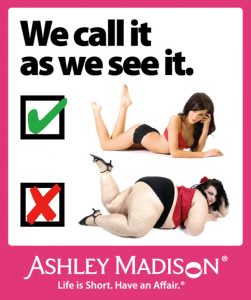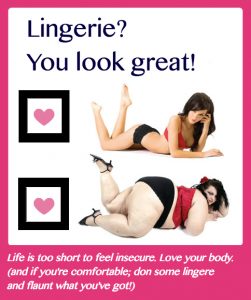
This advertisement is for ‘Ashley Madison,’ a company that specializes in helping men cheat on their spouses with ‘attractive’ women in a discreet manner. This advertisement goes a step further than just tantalizing men with the prospect of thrilling secretive sex with an attractive (and perhaps younger) woman: it implies that if a man is sexually dissatisfied with his wife’s appearance, that he should cheat on her with someone that is more conventionally attractive. Within out society, the standard of beauty for a woman that is to be considered ‘attractive’ is that she should be: typically slender yet curvaceous, symmetrical and delicate features, even skin-tone. These physical attributes of beauty are naturally only attainable by a small portion of the population. Further, this ad implies that married women who gain weight are unattractive and less desirable than slimmer, single women.
The line ‘We call it as we see it” is followed by the pictures of two women in lingerie. Before even delving into the logistics of how these women look and where the ad judges them in terms of their physical appearance, we must address the flaws with the above statement. As Ashley Madison is a website designed for and marketed towards men, the ‘we’ in the aforementioned line is intended to embody the universal voice of heterosexual men. This line then continues to position men in a place to judge women based upon the merits of their physical appearance, and words itself in a way that deems these judgements as honest, rather than as product of social conditioning to find a certain type of physical appearance attractive. Then, the two lingerie clad woman are judged as such: the slim, more conventionally attractive woman receives a check mark, while the larger, less conventionally attractive woman receives a red ‘x.’
To know that an advertisement that so bluntly judges women’s appearances exists on the internet and know that it is taken seriously (thousands upon thousands of men use this service) is disheartening, yet, not surprising. The porn industry as a whole (and lots of media, though to a lesser and more subtle extent) often judges women based upon how conventionally attractive they are. The advertisement takes this a step even further, by implying that both of these women exist for the viewing pleasure of the man examining them, and that he is deserving of choosing between them. This ad thus prompts the objectification of the women within it, any by proxy, every woman that men lump to fall into one of either category that these two women represent.

For my jam, I wanted to take the original advertisement and totally turn it on its head: I decided to take a body positive, woman focused take on it. Where the Ashley Madison advertisement aimed to show the disparity between the two women, and to thus rank one as physically superior to the other, my ad aims to show that both bodies are beautiful. I removed the check mark and X from the boxes beside the women and, instead, replaced them with a pink heart. This removes the value-judging in the original advertisement in favor of a display of appreciation for both women, and acceptance for both body types.
The initial advertisement presents these women as objects for men’s viewing pleasure, and provokes the thought that these women are dressed up to please men. In the jammed version of this advertisement, I chose to make the intended audience women, and to address them directly. I also intentionally avoided bringing up the notion that women would wear lingerie for a partner or anyone but themselves. It was important to me to crush the idea that one can only dress in clothing such as lingerie for another’s pleasure; you can absolutely don lingerie for yourself to feel beautiful and empowered. Another reason I avoided mentioning men in this jammed advertisement was to avoid alienating women who do not take men (or anyone) as sexual partners; the message of body positivity and sexual expression is not limited to those who are heterosexual.
In the future, I would love to see more advertisements in the same vein of my jammed ad. There are so many advertisements that sexualize, objectify and reduce women’s worth to their appearance and how attractive society deems them to be. Messages of body positivity are incredibly important, whether they are about being comfortable and confident in dressing up and showing skin like in this jammed advertisement, or if they tackle the same message in a more metaphorical or more modest way. The jammed advertisement I made had me utilizing all of my limited Photoshop knowledge, but it is my dream for professionals in the marketing field to one day create similar yet more elegant advertisements. It would be amazing to see ads with bodies of different genders and races to further promote the image of self-love, diverse beauty and body positivity. I think that as it stands, my culture jammed advertisement directly confronts and fixes the majority of the issues in the original Ashley Madison advertisement.